In the annals of military history, the Indian Army stands as a testament to bravery, sacrifice, and unwavering dedication. Comprising numerous regiments, each with its own illustrious history and traditions, the Indian Army embodies a rich tapestry of heritage and valor.
Central to the ethos of these regiments are their mottos and war cries, encapsulating the spirit and resolve of the soldiers who serve under their banner.
From the snow-capped peaks of the Himalayas to the deserts of Rajasthan, from the dense jungles of the Northeast to the plains of Punjab, Indian Army regiments have served the nation with distinction in various theaters of conflict and peacekeeping missions.
Behind every regiment lies a legacy of gallantry and resilience, upheld by the men and women who wear its uniform.
Indian Army War Cry
Let us delve into the heart of the Indian Army, exploring the mottos and war cries that echo across its ranks:
INDIAN ARMY
- Motto: Service Before Self.
- War Cry: Jai Hind, Bharat Mata Ki Jai, Vande Mataram.
- One of the strongest and biggest armies in the world.
- Current Chief: General Manoj Mukund Naravane
- President is the Supreme Commander of the Indian Army.
- There are 6 major commands in the Indian Army.
MADRAS REGIMENT
- Motto: “Swadharme Nidhanam Shreyaha (It is a glory to die doing one’s duty)
- War Cry: Veera Madrassi, Adi Kollu, Adi Kollu (Brave Madrassi, Strike and Kill, Strike and Kill!)
- Regimental Centre: Wellington, Tamil Nadu
- Active From: 1758.
The Madras Regiment is one of the oldest infantry regiment of the Indian Army, originating in the 1750s. The regiment took part in numerous campaigns with both the British Indian Army and the post-independence Indian Army. After independence, the infantry battalions of the Travancore “Nair Pattalam”, Cochin and Mysore State forces were amalgamated into the Madras Regiment. Post-independence saw the consolidation of the Regiment and re-affirmation of the versatility and valour of the South Indian troops when the battalions of the Regiment fought fierce battles during the 1947–48 Jammu & Kashmir Operations, the 1962 Sino-Indian Conflict and the Indo-Pak Wars of 1965 and 1971. The deployment of as many as seven battalions of the Regiment in Sri Lanka during Operation Pawan in 1987–89 was a testimony to the faith the Indian Army reposed in the loyalty, dedication, and valour of the troops of the Madras Regiment. Two battalions (3 and 25 Madras) of the Regiment have been awarded unit citations by the COAS in recognition of their splendid service in combating insurgency in Jammu & Kashmir and Punjab. Further two battalions served the nation, in the world’s highest battlefield in the sub-zero temperatures of Siachen Glacier. The Madras Regiment has taken part in various humanitarian aid operations in India. It has also taken part in various UN Peacekeeping missions.
THE BRIGADE OF THE GUARDS
- Motto: Pehla Hamesha Pehla (First Always First)
- War Cry: “Garud ka hun bol pyare” (I am the son of Garuda, Say O my friend)
- Regimental Centre: Kamptee, Maharashtra
- Active From: 1948.
The Brigade of The Guards is a mechanised infantry regiment of the Indian Army. It was raised as the first “all India”, “all class” infantry regiment of the Army where troops from all parts of India serve together, as opposed to other regiments that recruit from specific regions, ethnic groups, or religions. The Brigade of The Guards distinguished itself by being awarded the greatest number of battle honours after Indian independence. The regiment was the brainchild of Field Marshal K. M. Cariappa, who was the first Indian commander-in-chief (C-in-C) of the Indian Army. He raised the Brigade of the Guards and coined the phrase; “The Guards, The Elite”. The President of India is the Honorary Colonel-in-Chief and the Chief of Army Staff is the Colonel-in-Chief of The Guards. The Guards Regimental Centre is at Kamptee in Maharashtra. The Brigade of The Guards was the senior most line infantry regiment of the Indian Army before its selection and conversion to the mechanised infantry role. It now holds the title of the senior most infantry regiment in an honorary/ceremonial capacity. Together with the Mechanised Infantry Regiment, they form part of the ‘Mechanised Infantry’ arm, part of the Mechanised Forces (along with the Armoured Corps).
MECHANISED INFANTRY REGIMENT
- Motto: Valour and faith
- War Cry: Bolo Bharat Mata ki jai
- Regimental Centre: Ahmednagar, Maharashtra
- Active From: 1979
The Mechanised Infantry Regiment is an infantry regiment of the Indian Army, comprising 27 battalions dispersed under various armoured formations throughout India. It is one of the youngest regiments in the army, and though it was formed as a result of lessons learned in the 1965 Indo-Pak War, to give infantry battalions greater mobility, it was the mastermind of late Gen K Sundarji who had the foresight to cater the needs of a modern army. The Mechanised Infantry Regiment has participated in Operation Pawan in Sri Lanka, Operation Rakshak in Punjab and Jammu & Kashmir and Operation Vijay in Jammu & Kashmir. It also specialises in UN Peacekeeping Operations in Somalia, Congo, Angola, and Sierra Leone. The Regiment has its affiliation to INS Gharial of the Indian Navy. The Mechanised Infantry Regiment of the Indian Army has a special distinction of operating even in the high-altitude areas of Ladakh and Sikkim. Gen Sundarji was appointed the first Colonel of the Mechanized Infantry Regiment, the post he held till his retirement.
RAJPUTANA RIFLES
- Motto: “Veer bhogya vasundhara” (The brave shall inherit the earth)
- War Cry: “Raja Ramachandra ki jai” (Victory to King Ramachandra)
- Regimental Centre: Delhi Cantonment
- Active From: 1775
The Rajputana Rifles is the oldest rifle regiment and one of the senior-most regiments of the Indian Army. It was originally raised in 1921 as part of the British Indian Army, when six previously existing regiments were amalgamated to form six battalions of the 6th Rajputana Rifles. In 1945 the numeral designation was dropped from the title and in 1947 the regiment was transferred to the newly independent Indian Army. Since independence, the regiment has been involved in a number of conflicts against Pakistan, as well as contributing to the Custodian Force (India) in Korea under the aegis of the United Nations in 1953-54 and to the UN Mission to the Congo in 1962. Over the course of its existence, members of the regiment have received six Victoria Crosses, two Military Crosses, one Param Vir Chakra, three Ashok Chakras, one Padma Bhushan, fourteen Param Vishisht Seva Medals, ten Maha Vir Chakras, eleven Kirti Chakras, 18 Ati Vishisht Seva Medals, two Uttam Yudh Seva Medal, 50 Vir Chakras, 28 Shaurya Chakras, 122 Sena Medals (including Bar), 39 Vishisht Seva Medals, three Yudh Seva Medals, 85 Mentions-in-Dispatches and 55 Arjun Awards.
RAJPUT REGIMENT
- Motto: “Sarvatra vijay” (Victory everywhere)
- War Cry: “Bol Bajrang Bali Ki jai” (Say victory to Lord Hanuman)
- Regimental Centre: Fatehgarh, Uttar Pradesh
- Active From: 1778
The Rajput Regiment is an infantry regiment of the Indian Army. It is composed primarily of troops from the Rajput, Ahir and Gurjar community. During the Second World War, the class composition of the regiment was 50% Rajput and 50% Muslim. This regiment has participated in almost all major wars of the Indian Army. Awards and decorations of this regiment include 1 Param Vir Chakra, 3 Ashoka Chakra, 5 Param Vishisht Seva Medals, 7 Maha Vir Chakras, 12 Kirti Chakras, 5 Ati Vishisht Seva Medals, 66 Vir Chakras, 20 Shaurya Chakras 8 Yudh Seva Medals, 313 Sena Medals, 19 Vishisht Seva Medals, 1 Bar to Vishisht Seva Medal, 1 Padma Shri.
DOGRA REGIMENT
- Motto: “Kartavyam anvatma” (Duty before death)
- War Cry: “Jawala Mata ki jai” (Victory to Goddess Jawala)
- Regimental Centre: Faizabad, Uttar Pradesh
- Active From: 1877
The Dogras, the inhabitants of ‘Duggar’ or Dogra land hail from the Indian states of Jammu and Kashmir, Himachal Pradesh, and the hilly regions of Punjab. The Dogra Regiment traces its lineage to 1858, when the Agra Levy was raised by the British East India Company as part of the Bengal Army. A company from the 4th battalion fought in the battle of Walong in November 1962 and suffered significant casualties against a vastly numerically superior Chinese force. On the eastern front, the 9th battalion was responsible for the fall of Suadih, a small village in East Pakistan that was a strong bastion of the Pakistan Army’s most fortified position in the country. This led to the ultimate liberation of East Pakistan and a victory for the Indian Army. For this task, 9 Dogra was awarded the battle honour of Suadih. The 5th battalion fought in the Kargil War to capture Tiger Hill. The Dogra Regiment has not only contributed to the United Nations Peacekeeping Forces in the Gaza Strip, Korea, and the Congo, but has also contributed in providing various military observers in various peace keeping operation around the globe. The 1st, 3rd and 9th battalions have participated in UN peacekeeping missions. The recruitment of troops into the Dogra Regiment has been that of a fixed class composition: 50 percent from Himachal Pradesh, 25 percent from Jammu and Kashmir, and a balance from Hoshiarpur, Nawanshahr, Gurdaspur, and Rupnagar districts of Punjab. Enlisting in army is seen as honourable pursuit for Dogras; soldiering has not only become a substantial part of the economic structure of the Dogra hills, but created social and cultural traditions built on the people’s association with the army.
SIKH REGIMENT
- Motto: “Nischay kar apni jeet karon” (With determination, I will be triumphant)
- War Cry: “Jo bole So Nihal, sat sri akal” (He who cries ‘God is truth’ is ever happy)
- Regimental Centre: Ramgarh Cantonment, Jharkhand
- Active From: 1846
The Sikh Regiment is an infantry regiment of the Indian Army that recruits from the Sikh community. It is the most decorated regiment of the Indian Army and in 1979, the 1st battalion was the Commonwealth’s most decorated battalion with 245 pre-independence and 82 post-independence gallantry awards, when it was transformed into the 4th battalion, Mechanised Infantry Regiment. The first battalion of the regiment was officially raised just before the annexation of the Sikh Empire on August 1, 1846, by the British East India Company. Currently, the Sikh Regimental Centre is located in Ramgarh Cantonment, Jharkhand. The Centre was earlier located in Meerut, Uttar Pradesh. About 5000 Indian soldiers, some belonging to the regiment, mutinied after the storming of the Golden Temple by the Indian Army as part of Operation Blue Star in 1984. 21 soldiers of the 36th Sikhs were posthumously awarded the Indian Order of Merit for their actions in the Battle of Saragarhi in 1897.
SIKH LIGHT INFANTRY
- Motto: “Deg teg fateh” (Prosperity in peace and victory in war)
- War Cry: “Jo bole So Nihal, sat sri akal” (He who cries ‘God is truth’ is ever happy)
- Regimental Centre: Fatehgarh, Uttar Pradesh
- Active From: 1944
The Sikh Light Infantry is a light infantry regiment of the Indian Army. The regiment is the successor unit to the 23rd, 32nd and 34th Royal Sikh Pioneers of the British Indian Army. The regiment recruits from the Sikh community of Himachal Pradesh, Punjab and Haryana states of India. The versatility of the Sikh Light Infantry has seen the regiment conduct operations from conventional warfare on the Siachen Glacier, the highest battlefield in the world, to counterterrorism. Units of the regiment have also been deployed as part of the United Nations Emergency Force. The regimental motto is “Deg Tegh Fateh”, meaning “prosperity in peace and victory in war”. The motto has great significance with the tenth Sikh guru, Guru Gobind Singh, with whom the Mazhabi community is very strongly associated. The regiment’s cap badge is a chakram or quoit, with a mounted kirpan. The insignia was designed to honour the Mazhabi community’s Akali Nihang ancestry.
JAT REGIMENT
- Motto: “Sangathan va veerta” (Unity and Valour)
- War Cry: “Jat balwan, jai bhagwan” (The Jat is strong, victory to God)
- Regimental Centre: Bareilly, Uttar Pradesh
- Active From: 1795
The Jat Regiment is part of the infantry of the Indian Army, of which it is one of the longest-serving and most-decorated regiments. The regiment has won 19 battle honours between 1839 and 1947, and post-independence it has won five battle honours, eight Mahavir Chakra, eight Kirti Chakra, 32 Shaurya Chakras, 39 Vir Chakras and 170 Sena Medals. During its 200-year service history, the regiment has participated in various actions and operations in India and abroad, including the First and the Second World Wars.
PARACHUTE REGIMENT
- Motto: “Shatrujeet” (The conqueror)
- War Cry: “Balidan Param Dharma” (Sacrifice Before Duty)
- Regimental Centre: Bengaluru, Karnataka
- Active From: 1945
The Parachute Regiment is an airborne forces and special forces regiment of the Indian Army. Various participations include the World War 2, Indian independence, Indo-Pakistani War of 1947, 60 Parachute Field Ambulance and the Korean War, Indo-Pakistani War of 1965, Indo-Pakistani War of 1971, Operation Pawan, Operation Cactus, Counter insurgency operations, Kargil War and various United Nations operations. Recently, two more airborne battalions were raised by transfer from other regiments. In 2013, the 23rd battalion, Rajputana Rifles was transferred to the Parachute Regiment and redesignated as the 23rd battalion, Parachute Regiment. In 2014, the 29th battalion, Rajput Regiment was transferred to the Parachute Regiment and redesignated as the 29th battalion, Parachute Regiment. The regiment has a total of fourteen regular, one Rashtriya Rifles and two Territorial Army battalions. Of the regular battalions, five are airborne infantry battalions, while nine are special forces battalions. Formerly designated “Commando” units, they are now designated “Special Forces”. Numerous soldiers of the regiment have been awarded honours for bravery in operations. These include 7 Ashoka Chakras, 11 Maha Vir Chakras, 13 Kirti Chakras, 7 Param Vishisht Seva Medals, 6 Uttam Yudh Seva Medals, 13 Ati Vishisht Seva Medals, 61 Vir Chakras, 53 Shaurya Chakras, 10 Yudh Seva Medals, 28 Vishisht Seva Medals, 246 Sena Medals, 5 Bar to SM, 265 Mentioned in Dispatches.
PUNJAB REGIMENT
- Motto: “Sthal wa jal” (“by land and sea”)
- War Cry: “Jo bole So Nihal, sat sri akal” (“he who cries ‘God is truth’ is ever happy”); “Bol Jawala Ma ki jai“ (Say victory to Goddess Jawala)
- Regimental Centre: Ramgarh Cantonment, Jharkhand
- Active From: 1757
The Punjab Regiment is one of the oldest in the Indian Army. The first battalion which today constitutes this regiment was raised in 1805, by the then Maharaja of Patiala. The first four British-raised battalions of what later became the 2nd Punjab Regiment and finally the Punjab Regiment, were raised during the hostilities in the Carnatic in South India between 1761 and 1776. The first and second battalions have been moved to other regiments and the fourth battalion was disbanded. The third battalion still continues as part of the regiment. The numbers and titles of the battalions changed during the successive reorganisations of the Madras Presidency Army, the British Indian Army and the Indian Army during the 18th, 19th and 20th centuries. The names changed from Coast Sepoys to Carnatic Infantry, Madras Native Infantry, Punjabis and finally to the Punjab Regiment. In recent years, the Punjab Regiment has contributed towards UN peacekeeping missions by sending six of its battalions overseas: 3 Punjab to Gaza, 14 Punjab to Angola, 15 and 26 Punjab to Lebanon and 16 and 24 Punjab to the Democratic Republic of the Congo. During the Indo-Pakistan War of 1971, a Company (reinforced) of the 23rd battalion, Punjab Regiment, consisting of about 120 soldiers under the command of Major (later Brigadier) Kuldip Singh Chandpuri, fought off an assault by a brigade of the Pakistan Army. The battle was fought at the desert border post of Longewala, Rajasthan. The unit fought during the last five hours of the night of 5 December 1971 unsupported as the Indian Air Force aircraft at the time did not have night attack capabilities. For his leadership during the battle, Maj. Chandpuri was decorated with the Maha Vir Chakra, the second highest gallantry award in India. The regiment is perhaps the only infantry regiment with naval galley as an insignia, anywhere. It was awarded to 69th Punjabis (later 2nd Punjab) in recognition of the readiness to serve overseas, after the battalion had fought in eight overseas campaigns by 1824.
PART – 2
THE GRENADIERS
- Motto: “Naam Namak Nishaan”
- War Cry: “Sarvada Shaktishali” (Ever Powerful)
- Regimental Centre: Jabalpur, Madhya Pradesh
- Active From: 1778.
This is an infantry regiment of the Indian Army. The regiment has won many battle honours and gallantry awards and is considered to be one of India’s most decorated regiments with three Param Vir Chakra awardees in three different conflicts. The concept of ‘Grenadiers’ evolved from the practice of selecting the bravest and strongest men for the most dangerous tasks in combat. The Grenadiers have the longest unbroken record of existence in the Indian Army. Subedar Major Yogendra Singh Yadav PVC is a Junior Commissioned Officer (JCO) in this regiment, who was awarded the highest Indian military honour decoration, the Param Vir Chakra, for his action during the Kargil War. Aged 19 when he received the decoration, he is the youngest person to be awarded the medal.
THE MARATHA LIGHT INFANTRY REGIMENT
- Motto: “Duty, honour, courage”
- War Cry: “Bolo Shri Chhatrapati Shivaji Maharaj ki jai” (Say victory to Emperor Shivaji).
- Regimental Centre: Belgaum, Karnataka
- Active From: 1768.
This regiment traces its lineage to the Bombay Sepoys, raised in 1768, making it the most senior light infantry regiment in the Indian Army. The class composition of the regiment was and is primarily formed by Maratha recruits from the former Maratha Empire. The men are mostly drawn from all over the state of Maharashtra, with some percentage from Marathi-speaking areas of Karnataka including Coorg. The regiment has the honour of being the most decorated regiment of the Indian Army and has won over 60 battle honours. In the First World War they won 21 battle honours which was the most by any regiment.
GARHWAL RIFLES
- Motto: “Yudhaya Krit Nishchaya” (Fight with Determination)
- War Cry: “Badri Vishal Lal Ki Jai” (Victory to the Sons of Lord Badri Nath)
- Regimental Centre: Lansdowne, Uttarakhand
- Active From: 1887.
This regiment was originally raised in 1887 as the 39th (Garhwal) Regiment of the Bengal Army. It then became part of the British Indian Army, and after the Independence of India, it was incorporated into the Indian Army. The Regiment has to its credit 03 Victoria Cross, 01 AC, 06 MVCs, 14 KCs, 52 VrC, 46 SC, 10 PVSM, 01 UYSM, 08 YSM, 284 SM (including 06 Bar), 17 AVSM (including 01 Bar) and 40 VSM (including 01 Bar). The regimental insignia incorporates a Maltese Cross and is based on the defunct Rifle Brigade (Prince Consort’s Own) as they are a designated rifle regiment. Lansdowne, at a height of 5,800 ft (1,800 m) above sea level, is the recruitment centre of the Garhwal Rifles. On 1 October 1921, the regimental centre celebrated its first Founder’s Day. Now 1 October is celebrated as the raising day of the battalion. After Independence, the name of the centre was changed to Garhwal Rifles Regimental Centre. The rigorous drills during the training helps to infuse a sense of discipline in every recruit. Special emphasis is laid on physical fitness, mental toughness, and weapon handling. After successful completion of the 34-week training course, a Garhwali youth is turned into a soldier. The soldier is then trained for two more weeks in counter-insurgency operations.
THE KUMAON REGIMENT
- Motto: “Parakramo Vijayate” (Valour Triumphs)
- War Cry: “Kalika Mata Ki Jai” (Victory to the Great Goddess Kali)
- Regimental Centre: Ranikhet, Uttarakhand
- Active From: 1813.
This regiment is the most decorated infantry regiment of the Indian Army. The regiment traces its origins to the 18th century and has fought in every major campaign of the Indian Army, including the two world wars. The Kumaon Regiment, established at Ranikhet in 1917, still gets its recruits from the Kumaon : Brahmins and Kshatriya of the Kumaon division and Yadav people from the plains. The troop composition has been 80% Kumaonis and 20% Yadav people. This regiment owns the honour of backing Major Somnath Sharma under its name, the one who is the first recipient of PVC.
ASSAM REGIMENT
- Motto: “Assam vikram” (“unique valour”)
- War Cry: “Rhino Charge”
- Regimental Centre: Happy Valley, Shillong, Meghalaya.
- Active From: 1941.
This regiment consists of 25 battalions: 15 regular battalions, 3 Rashtriya Rifles battalions, 5 Territorial Army infantry and ecological battalions and 2 battalions of Arunachal Scouts. It recruits exclusively from all the Seven Sister States of northeast India. The regimental salutation of “tagra raho” (“stay strong/fit”) is unique in the Indian Army. This unique greeting was introduced by the regiment’s commanding officer during the 1960s, the late Major General S. C. Barbora. He used to inquire about the morale of his soldiers by asking them “tagra ho?” (“are you strong/fit?”). Invariably, the answer used to be “tagra hai Saheb” (I am strong/fit, sir). This greeting became popular in a noticeably short period of time. Also, the popular drill song “Badluram ka Badan Zameen ke Niche hai” is actually the regimental song of this regiment. The regiment wears a hat, called the Rhino Hat, with the right side lowered, a Rhino with a black diamond-shaped flash on the left (Rhino facing front) and black strap under the chin. A ceremonial ‘Dah’ is also carried with the belt on ceremonial occasions.
THE BIHAR REGIMENT
- Motto: “Karam Hi Dharam” (Work is Worship)
- War Cry: “Jai Bajrangbali” (Victory to Lord Hanuman / Bajrangbali)
- Regimental Centre: Danapur Cantonment, Patna, Bihar
- Active From: 1941.
This regiment was formed in 1941 by regularising the 11th (Territorial) Battalion, the 19th Hyderabad Regiment, and raising new battalions. This highly decorated regiment is affiliated to INS Vikramaditya, the largest warship of the Indian Navy which is also India’s sole aircraft carrier. During the early days of its formation, the regiment recruited soldiers mainly from Rajputs and Bhumihar castes of Bihar & Jharkhand. Later Yadavas, Koeri, Kurmi and tribals from Bihar and Jharkhand were also recruited. Deployments of units of the Bihar Regiment were done in Burma Campaign of World War II, Operation Zipper of World War II, Indo-Pakistan War of 1947, Indo-Pakistan War of 1965, Indo-Pakistan War of 1971, UN Operation in Somalia, Kargil War 1999, and UN Mission to Congo.
THE MAHAR REGIMENT
- Motto: “Yash Siddhi” (Success & Attainment)
- War Cry: “Bolo Hindustan Ki Jay” (Say Victory to India)
- Regimental Centre: Saugor, Madhya Pradesh
- Active From: 1941.
This regiment is an infantry regiment of the Indian Army. Although it was originally intended to be a regiment consisting of troops from the Mahar community of Maharashtra, now days since the candidates from mahar community do not show major interest to join army, the mahar regiment later changed its composition into different communities from mainly states like Maharashtra, Madhya Pradesh, Uttar Pradesh and Bihar. The year 1965 saw all the battalions of the regiment gearing up for operations. These included the newly raised 11th and 12th battalions that had the unique composition of Bengalis, Oriyas and Gujaratis – the communities that had been stamped as non-martial by the British. Their entry into the Mahar fraternity added strength to national integration-the distinctive feature which the regiment has always been proud of.
THE JAMMU AND KASHMIR RIFLES
- Motto: “Prashata Ranvirta” (Valour in Battle is Praiseworthy)
- War Cry: “Durga Mata Ki Jai” (Victory to Goddess Durga)
- Regimental Centre: Jabalpur, Madhya Pradesh
- Active From: 1821.
This regiment is one of the most prestigious infantry regiment of the Indian Army. Its origins lay in the Jammu and Kashmir State Forces of the princely state of Jammu and Kashmir. After the accession of the state to the Indian Union in October 1947, the State Forces came under the command of the Indian Army. They remained in the original form until 1956 when Jammu and Kashmir Constituent Assembly effectively ratified the state’s accession to India. Then the State Forces became the Jammu and Kashmir Regiment of the Indian Army. In 1963, the designation was changed to Jammu and Kashmir Rifles. After the conversion, the Ladakh Scouts came under the aegis of the Regiment, where it remained until raised as a separate Regiment in 2002. Captain Vikram Batra, a recipient of PVC, from whom most of the defence aspirants take their motivation is from this regiment.
JAMMU & KASHMIR LIGHT INFANTRY REGIMENT
- Motto: “Balidanam Vir Lakshanam” (Sacrifice is a characteristic of the Brave)
- War Cry: “Bharat Mata Ki Jai” (Victory to Mother India)
- Regimental Centre: Awantipora, J&K.
- Active From: 1947.
This regiment’s regimental insignia consists of a pair of crossed rifles. The regiment mostly consists of volunteers from the state of Jammu & Kashmir. 50% of the regiment’s troops are Muslims while the rest represent other ethnic groups from the state. The Jammu and Kashmir Light Infantry is considered to be the most decorated regiment of the Indian army having won 1 Param Vir Chakra and 3 Ashok Chakra. In 1984, units of the JAK LI were deployed to the Siachen Glacier as part of Operation Meghdoot. In 1987, JAK LI units were deployed to Sri Lanka as part of Operation Pawan. In 1999, JAK LI earned honours in the Kargil War. The Chief of Army Staff made a special instant award of “Unit Citation” to the 12th battalion for their exceptionally gallant and sterling performance during the battles of Point 5203 on the night of 10/11 June 1999 and Point 4812 on the night of 30 June/1 July 1999 in Batalik. The overall performance of the battalion during Operation Vijay was exceptional and marked with exemplary valour and grit in the face of the enemy.
PART – 3
NAGA REGIMENT
- Motto: “Parakramo Vijayate” (Valour triumphs)
- War Cry: “Jai Durga Naga” (Hail Durga Naga)
- Regimental Centre: Ranikhet, Uttarakhand
- Active From: 1970.
The first battalion of the regiment (1 Naga) was raised at the Kumaon Regimental Centre, Ranikhet on 1 November 1970 under the command of Lt. Col. R.N. Mahajan, VSM. Being the only battalion, it was then designated as the Naga Regiment. The manpower to raise this battalion was provided by battalions of the Kumaon Regiment, Garhwal Rifles and 3 Gorkha Rifles. The traditional Naga weapons viz the Dao, the Spear and the prestigious Mithun have been integrated into the Regimental Crest. The regiment’s colours are gold, green and red – the gold signifies the rising sun, the green signifies the infantry and red is the colour of authority among Nagas. 1 Naga was presented with ‘Colours’ on 6 May 1978 at Dehradun by Shri Neelam Sanjeeva Reddy, the President of India and 2 Naga was presented with ‘Colours’ on 10 May 1990 by General V.N. Sharma, PVSM, ADC, the Chief of Army Staff. Operation Romeo, Indo-Pakistani war of 1971, UN Mission to South Sudan and Kargil war are some of the major military conflicts in which this regiment took a major part.
THE GORKHA REGIMENTS
- Motto: Different for various Regiments.
- War Cry: “Jai Mahakali Ayo Gorkhali” (Hail goddess Kali, the Gorkhas are here)
Since the independence of India in 1947, as per the terms of the Britain–India–Nepal Tripartite Agreement, six Gorkha regiments, formerly part of the British Indian Army, became part of the Indian Army and have served ever since. The troops are mainly from ethnic Nepali Gurkhas of Nepal and ethnic Nepalese origin people known as Nepali Gorkha They have a history of courage in battle, evident from the gallantry awards won by Gorkha soldiers and battle honours awarded to Gorkha both before and after joining the Indian Army. A seventh Gorkha Rifles regiment was re-raised in the Indian Army after Independence to accommodate Gorkha soldiers of 7th Gurkha Rifles and the 10th Gurkha Rifles who chose not to transfer to the British Army. The Gorkha hat is wide brimmed, made of felt and is worn tilted.
| Name of Regiment | Estd. on | Motto of the Regiment | War Cry of the Regiment |
| 1 Gorkha Rifles | 1815 | “Kayar hunu bhanda marnu ramro” (Better to die than live like a coward) | “Jai Ma Kali, ayo Gorkhali” (Hail Goddess Kali, here come the Gorkhas) |
| 3 Gorkha Rifles | 1815 | ||
| 4 Gorkha Rifles | 1857 | ||
| 5 Gorkha Rifles (Frontier Force) | 1858 | “Shaurya Evam Nishta” (courage and determination) | |
| 8 Gorkha Rifles | 1824 | “Kayar hunu bhanda marnu ramro” (Better to die than live like a coward) | |
| 9 Gorkha Rifles | 1817 | ||
| 11 Gorkha Rifles | 1918-1922; from 1948 | “Yatraham vijayastatra” (Victory resides where I reside) |
The Regimental Centres of Gorkha Regiments are situated around the major cities in India. Basically, there are 4 Gorkha Training Centres across major cities. They are:
- 11 Gorkha Rifles Regimental Centre (11 GRRC) located in Lucknow, Uttar Pradesh
- 14 Gorkha Training Centre (14 GTC) located in Sabathu, Himachal Pradesh
- 39 Gorkha Training Centre (39 GTC) located in Varanasi, Uttar Pradesh
- 58 Gorkha Training Centre (58 GTC) located in Shillong, Meghalaya
Apart from this the Gorkha’s are mainly recruited from GRD (Gorkha Recruiting Depot) Kunraghat, Gorakhpur, Uttar Pradesh.
LADAKH SCOUTS
- Nick name: “Snow Warriors or Snow Tigers”
- War Cry: “Ki ki so so Lhargyalo” (Victory to God)
- Regimental Centre: Leh, Ladakh
- Active From: 1963.
Specializing in mountain warfare, the regiment’s primary role is to guard India’s borders in the high-altitude areas of the union territory of Ladakh. Raised by Colonel S.P. Salunke, the Ladakh Scouts were converted into an Army regiment in 2000. The Ladakh Scouts recruits mainly from India’s Ladakhi and Tibetan communities and is among the Indian Army’s most decorated units. Its soldiers have been honoured with over 300 gallantry awards and citations including one Unit citation, one Ashok Chakra, ten Maha Vir Chakras and two Kirti Chakras. Units of the Ladakh Scouts were deployed with a battalion of the Kumaon Regiment to capture the Siachen Glacier in April 1984, as a part of Operation Meghdoot. The Ladakh Scouts were one of the first units to be deployed in action in Operation Vijay. Its units displayed exemplary gallantry and won numerous awards, including a Maha Vir Chakra for Major Sonam Wangchuk. The presidential colours were presented to the regiment on 21 August 2017 by Ram Nath Kovind. The Ladakh Scouts have produced notable winter sport athletes, National Level Ice Hockey Players and many more national & ASIAN Level players.
ARUNACHAL SCOUTS
- Protectors of the Indo-Chinese border
- Training along with the Assam Rifles Regiment.
- Regimental Centre: Happy Valley, Shillong, Meghalaya.
- Active From: 2010.
The proposal to raise the Arunachal Scouts along the lines of the illustrious Ladakh Scouts for defending the border with China was proposed by former Indian Army chief and Governor of Arunachal Pradesh, General J. J. Singh, in 2008. The proposal was approved by the Union Cabinet in 2009. The new first battalion was carved out of the Assam Regiment. The first battalion was raised in 2010, and the second in 2012. On 1 May 2012, the 1st Battalion was given the primary responsibility for providing security for Arunachal Pradesh’s border with Tibet, supported by other regiments located farther from the border and the Indo-Tibetan Border Police. This regiment specialises in mountain warfare.
DOGRA SCOUTS
- Secure Indo-China border in the state of Himachal Pradesh at altitudes of 14000 feet.
- Regimental Centre: Kinnaur, Himachal Pradesh
- Active From: 1964.
Securing India’s border in extreme conditions requires bravery, sacrifice and patriotism. The brave soldiers of Dogra Scouts have all these three as they patrol the border with China in far-flung areas of Himachal Pradesh at a giddying altitude of 14,000 feet. Enviable energy and permanent passion reflect in their expressions and actions as soldiers here are regularly trained in ascending and descending steep mountains, constructing temporary bases on cliffs and on how to attack enemy intruders.
SIKKIM SCOUTS
- This regiment is affiliated with the 11th Gorkha Rifles, and use their insignia and flag, with the addition of the words “Sikkim Scouts”.
- Regimental Centre: Lucknow, Uttar Pradesh
- Active From: 2013.
The regiment Sikkim Scouts was raised on March 2013, yet the regiment was not functional or operational at that time. The hasty young guys of the youngest regiment of our country – Sikkim Scouts took adequate, proper training and became fully prepared for the hostilities at the year of 2015. The members (the omen of death for the enemies as a matter of fact) of this regiment are the children of the mountains of Sikkim (because, the each and every member of the regiment called Sikkim Scouts, is taken from the local population merely) , that’s why they are very much familiar with the alpine locus entirely. They know how to live here, how to survive here, how to battle from here.
THE REGIMENT OF ARTILLERY
- Motto: “Sarvatra Izzat-o-Iqbal” (Everywhere with Honour and Glory)
- War Cry: “Bharat Mata ki Jai” (Victory to Mother India)
- Regimental Centre: Nashik, Maharashtra
- Active From: 1827.
The Regiment of Artillery is an operational arm (a regiment/corps) of the Indian Army. Formerly part of Royal Indian Artillery (RIA) of British Indian Army which itself traces its origins to the formation of Bombay Artillery in 1827. It was later involved in extensive service in the First World War, in East Africa, Gallipoli, Mesopotamia and Palestine. Today it is the second-largest arm of the Indian Army, and with its guns, mortars, rocket launchers, unmanned aerial vehicles, surveillance systems, missiles, and artillery firepower it constitutes almost one-sixth of its total strength. In the artillery, the regiments have been divided into different units. They have been classified into Medium Regiments, Light Regiments, Missile Regiments, Rocket Regiments, SATA (Surveillance & Target Acquisition) Regiments, SATA (Surveillance & Target Acquisition) Battery and Field Regiments. Every Artillery unit has its own equipment during wartime. SATA Battery and SATA Regiments are the most important units in artillery as they are equipped with UAV Drones and ELM MAST Radar System.
ARMY AIR DEFENCE REGIMENTS
- Motto: “Akashe Shatrun Jahi” (Kill the Enemy in the Sky)
- War Cry: “Bharat Mata ki Jai” (Victory to Mother India)
- Army Air Defence College: Gopalpur Military Station, Odisha.
- Active From: 1939.
The Corps of Army Air Defence (abbreviated as AAD), is an active corps of the Indian Army and a major combative formation tasked with air defences of the country from foreign threats. The AAD Corps is responsible for the protection of Indian air space from enemy aircraft and missiles, especially below 5,000 feet. The history of the AAD dates back to 1939 during the times of the British Raj in India. The corps actively took part in the Second World War fighting on behalf of the British Empire. Post-independence, the corps has participated in all the wars involving India, starting from the 1947 Indo-Pakistani War to the 1999 Kargil conflict. The corps enjoyed autonomous status from 1994, after the bifurcation of the Corps of Air Defence Artillery from the Army’s artillery regiment. A separate training school, the Army Air Defence College (AADC), was established to train its personnel.
ARMOURED CORPS REGIMENTS
- Armoured Corps currently consists of 67 armoured regiments, including the President’s Bodyguards.
- Armoured Corps School and Centre: Ahmednagar, Maharashtra
- Active From: 1947.
The naming of the regiments varies. The terms “Cavalry”, “Horse” and “Lancers”, which have been dispensed with in the case of units raised post-independence, are historical legacies from the raising and renaming of these units when part of the East India Company’s army and/or later the British Indian Army. As a matter of tradition, each Armoured Regiment has its own “Colonel of the Regiment”, an honorary post for a senior officer who oversees the regimental issues concerning the unit. The Armoured Corps celebrates 1 May as its Corps Day.
REGIMENTS UNDER CORPS OF ENGINEERS
- The Corps consists of three groups of combat engineers, namely the Madras Sappers, the Bengal Sappers and the Bombay Sappers.
- Motto: “Sarvatra” (Everywhere)
- Headquarters: New Delhi, India
- Active From: 1777.
The Corps of Engineers of the Indian Army has a long history dating back to the mid-18th century. The earliest existing subunit of the Corps (18 Field Company) dates back to 1777 while the Corps officially recognises its birth as 1780 when the senior most group of the Corps, the Madras Sappers were raised. The Corps consists of three groups of combat engineers, namely the Madras Sappers, the Bengal Sappers, and the Bombay Sappers. A group is roughly analogous to a regiment of Indian infantry, each group consisting of a number of engineer regiments. The engineer regiment is the basic combat engineer unit, analogous to an infantry battalion. Besides the combat engineers, the Corps mans and operates major engineering organisations such as the Military Engineer Services, the Border Roads Organisation (BRO), the Married Accommodation Project and the Survey of India. College of Military Engineering, Pune (CME) is the premier technical and tactical training institution of the Indian Army Corps of Engineers.
There are various other regiments under various Corps of the Indian Army that support the organization in their duty aligned.
HOW’S THE JOSH?
| Military Unit | Motto | Language | Translation | War Cry | Translation |
|---|---|---|---|---|---|
| Indian Army | “Sewa Paramo Dharma” | Sanskrit | Service is our duty | “Bharat Mata ki jai” | “Victory to Mother India” |
| Indian Air Force | “Nabha sparsham deeptam” | Sanskrit | “Touch the sky with glory” | ||
| Indian Navy | “Sham-no Varuna” | Sanskrit | “May the Lord of the oceans be auspicious unto us” | ||
| Corps of Army Air Defence | “Aakasey satrun jahi” | Sanskrit | “Win over the enemy in the sky” | ||
| Army Medical Corps | “Sarve santu niramaya” | Sanskrit | “Freedom from sickness to all” | ||
| Regiment of Artillery | “Sarvatra izzat o iqbal” | Hindi/Urdu | “Everywhere with honour and glory” | ||
| Brigade of The Guards | “Pahla hamesha pahla” | Hindi/Urdu | “First, always first” | “Garud ka hun bol pyare “ | “I am the son of Garuda, Say O my friend” |
| Parachute Regiment | “Shatrujeet” | Hindi | “The conqueror” | “Balidaan parma dharam” | “Sacrifice before self” |
| Mechanised Infantry Regiment | “Valour and Faith” | English | “Bolo Bharat Mata ki jai” | “Say Victory to Mother India” | |
| Punjab Regiment | “Sthal wa jal” | Hindi | “By land and sea” | “Jo bole So Nihal, sat sri akal”; “Bol Jawala Ma ki jai” | “He who cries ‘God is truth’ is ever happy”; “Say victory to Goddess Jawala” |
| Madras Regiment | “Swadharme nidhanam shreyaha” | Sanskrit | “It is a glory to die doing one’s duty” | “Veera Madrasi, adi kollu, adi kollu” | “Brave Madrasi, hit and kill, hit and kill” |
| All Gorkha Rifles | “Kayar hunu bhanda marnu ramro” | Nepali | “Better to die than live like a coward” | “Jai Ma Kali, ayo Gorkhali” | “Hail Goddess Kali, here come the Gorkhas” |
| Maratha Light Infantry | “Kartavya, Maan, Saahas. | Hindi | Duty, Honour, Courage | “Bol Shri Chhatrapati Shivaji Maharaj ki jai” | “Say victory to King Shivaji” |
| The Grenadiers | “Sarvada shaktishali” | Sanskrit | “Ever powerful” | “Sarvada Shaktishali” | “Ever powerful” |
| Rajputana Rifles | “Veer bhogya vasundhara” | Sanskrit | “The brave shall inherit the earth” | “Raja Ramachandra ki jai” | “Victory to King Ramachandra” |
| Rajput Regiment | “Sarvatra vijay” | Sanskrit | “Victory everywhere” | “Bol Bajrang Bali ki jai” | “Say victory to Lord Hanuman” |
| Jat Regiment | “Sangathan wa veerta” | Hindi | “Unity and valour” | “Jat Balwan, jai bhagwan” | “The Jat is strong, victory to God” |
| Sikh Regiment | “Nischey kar apni jeet karon” | Punjabi | “With determination, I will be triumphant” | “Jo bole So Nihal, sat sri akal” | “He who cries ‘God is truth’ is ever happy” |
| Sikh Light Infantry | “Deg tegh fateh” | Punjabi | “Prosperity in peace and victory in war” | “Jo bole So Nihal, sat sri akal” | “He who cries ‘God is truth’ is ever happy” |
| Dogra Regiment | “Kartavyam anvatma” | Sanskrit | “Duty before death” | “Jawala Mata ki jai” | “Victory to Goddess Jawala” |
| The Garhwal Rifles | “Yudhaya krit nischya” | Sanskrit | “Fight With Determination” | “Badri Vishal Lal ki jai” | “Victory to the Great Lord Badri Nath” |
| Kumaon Regiment | “Parakramo vijayate” | Sanskrit | “Valour triumphs” | “Kalika Mata ki jai”; “Bajrang Bali ki jai”; “Dada Kishan ki jai” | “Victory to Goddess Kali”; “Victory to Lord Hanuman”; “Victory to Dada Kishan” |
| Assam Regiment | “Assam vikram” | “Unique valour” | Rhino charge[2] | ||
| Bihar Regiment | “Karam hi dharam” | Hindi | “Work is worship” | “Jai Bajrang Bali” | “Victory to Lord Hanuman” |
| Mahar Regiment | “Yash sidhi” | Sanskrit | “Success and attainment” | “Bolo Hindusthan ki jai” | “Say victory to India” |
| Jammu & Kashmir Rifles | “Prashata ranvirta” | Sanskrit | “Valour in battle is praiseworthy” | “Durga Mata ki jai!” | “Victory to Goddess Durga!” |
| Jammu and Kashmir Light Infantry | “Balidanam vir lakshanam” | Sanskrit | “Sacrifice is a characteristic of the brave” | “Bharat Mata ki jai” | “Victory to Mother India” |
| Ladakh Scouts | “Ki ki so so Lhargyalo” | “Victory to God” | |||
| Ordnance Corps | “Shastra se shakti” | Hindi | “Strength through weapons” | ||
| The Corps of Signals | “Teevra chaukas” | Hindi | “Swift and secure” | ||
| Corps of Engineers | “Sarvatra” | Sanskrit | “Everywhere” | ||
| Border Security Force | “Duty unto death” | English | |||
| Indian Coast Guard | “Vayam rakshamah” | Sanskrit | “We protect” | ||
| Border Roads Organisation | “Shramena Sarvam Sadhyam” | Sanskrit | “everything is achievable through hardwork” |


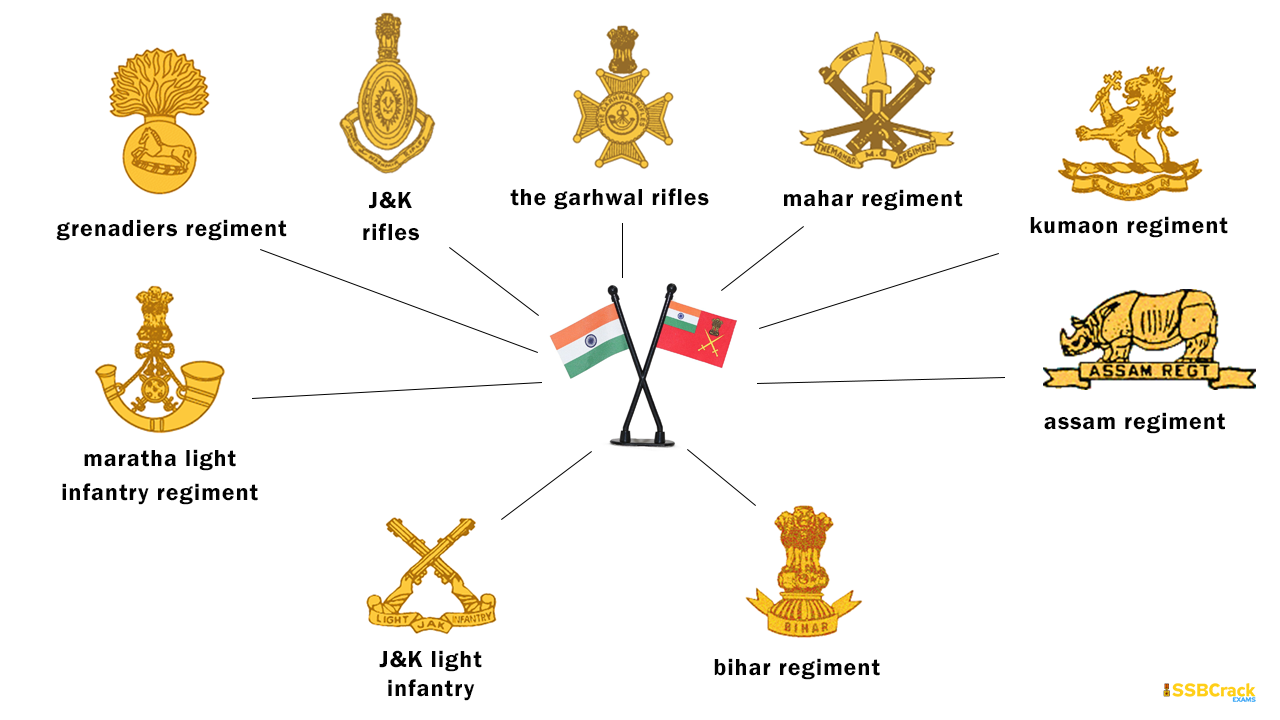
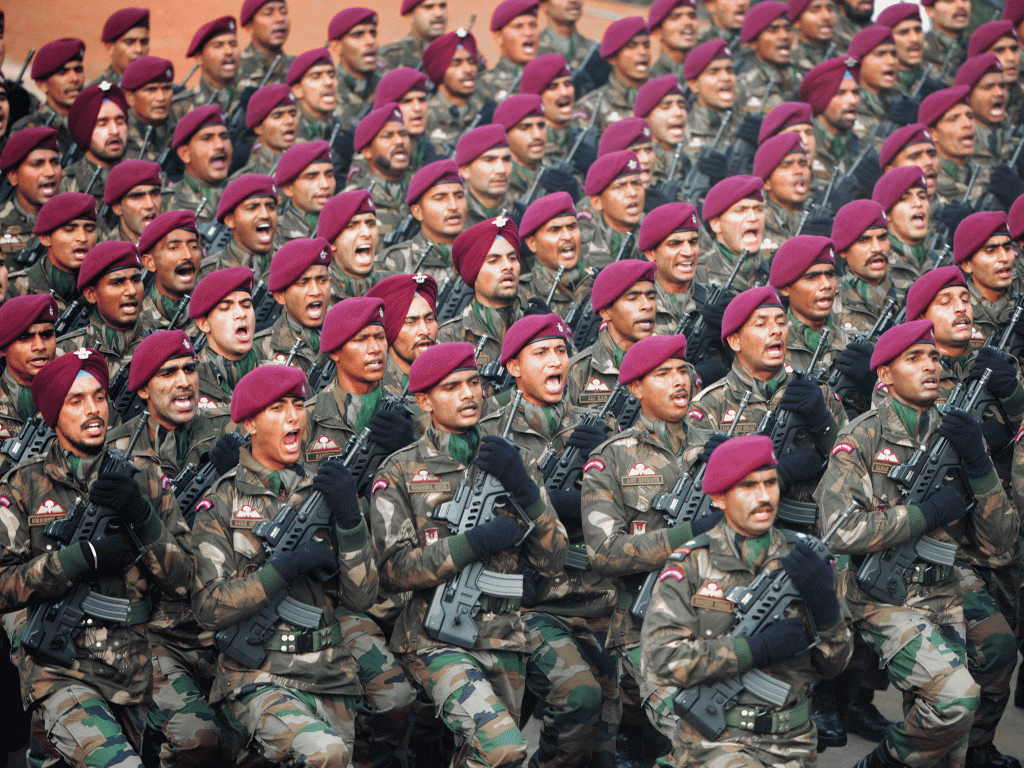


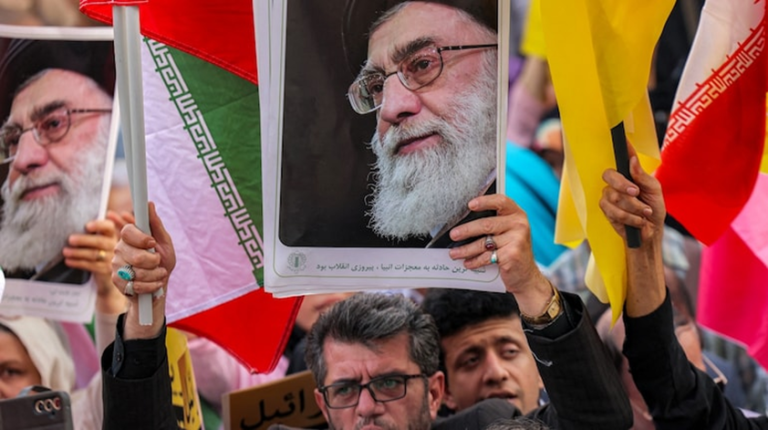
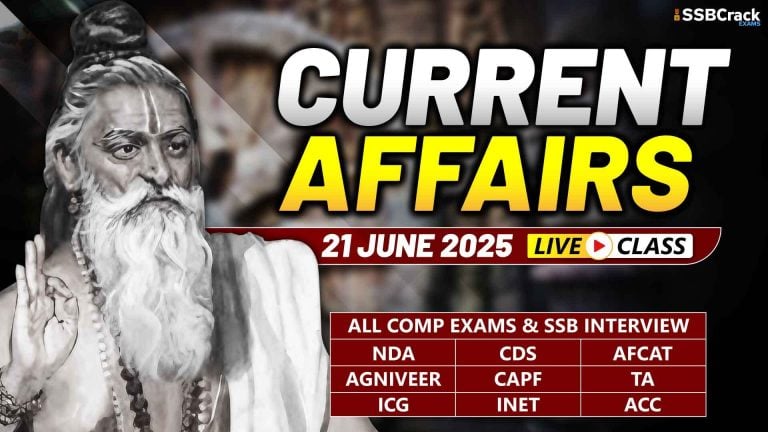

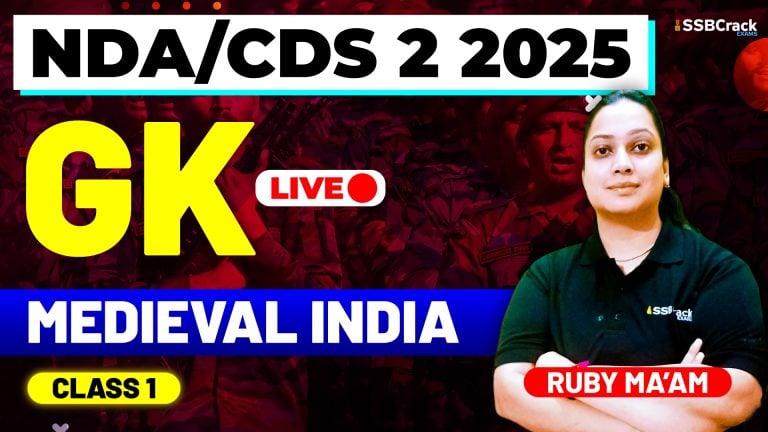

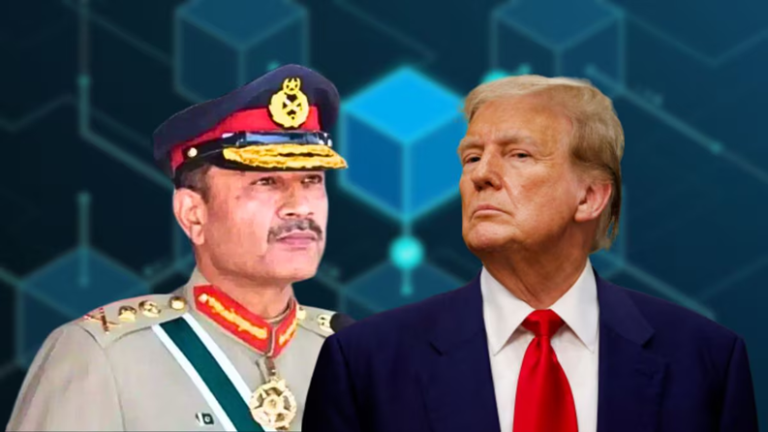

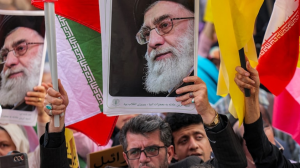


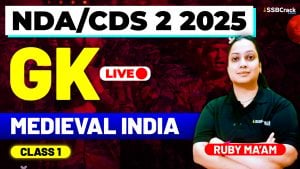

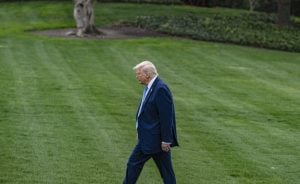

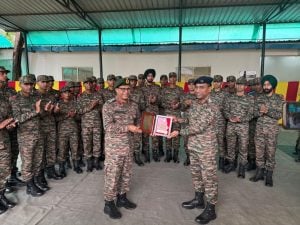

1 thought on “Indian Army Regiments Motto and War Cry [Full List]”
Why is EME regiment missing?